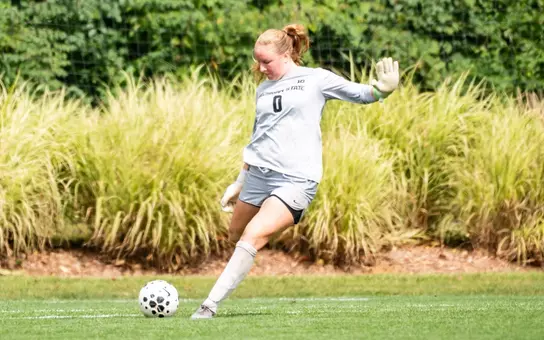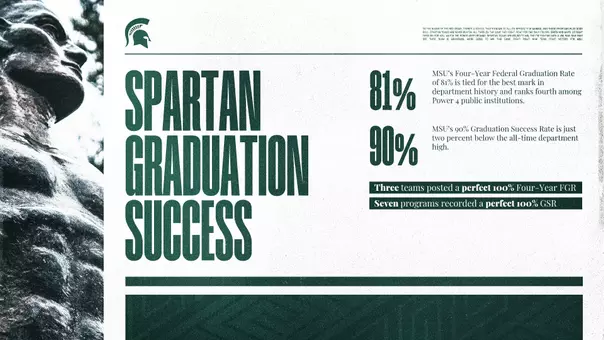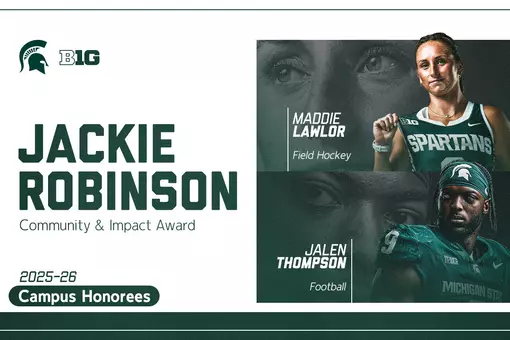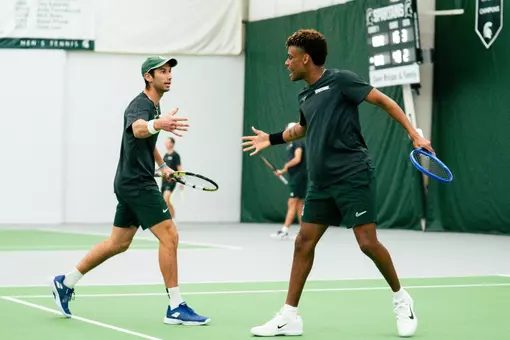MSU, BTN Partnership: A Game-Changer
2/26/2015 12:00:00 AM | General

By Steve Grinczel, MSUSpartans.com Online Columnist | @GrinzOnGreen
EAST LANSING, Mich. - Ten years ago, when he was the commissioner of the Central Collegiate Hockey Association, Tom Anastos thought the concept of a cable network devoted to Big Ten programming was a stroke of genius.
Anastos hasn't changed his tune as he nears the end of his fourth season at the helm of the Michigan State University hockey program.
Once a daring gamble, the Big Ten Network was a well-established broadcast partner by the time Anastos took over as the Spartans head coach. However, unlike those who initially doubted its sustainability, and scoffed at its early distribution difficulties, he embraced the idea as an affiliated league administrator.
"I thought it was absolutely brilliant," Anastos said. "The whole television game, just like any medium, is about content and managing content. And, there's this insatiable desire for sports. The timing couldn't have been better when you think about the evolution of reality TV shows.
"What better reality television is there than live sports?"
And so, as BTN reaches another milestone, fueled along the way certainly by its coverage of football and basketball, but also by field hockey and gymnastics, and insightful profiles of athletes from Lincoln to Piscataway, and thought-provoking looks at Big Ten athletic programs from inside the locker room out, Anastos can't overstate its impact.
"It's changed the financial model of college athletics," he said.
Furthermore, with its reach into more than 60 million American and Canadian homes, BTN has significantly altered the competitive landscape between conferences while spawning a host of imitators.
Anastos has experienced BTN's influence from the time it hawkishly found a way to televise CCHA games featuring MSU, Ohio State and Michigan (as well as Western Collegiate Hockey Association games with Wisconsin and Minnesota) to providing an even greater showcase for the Big Ten hockey league that came about with the addition of Penn State in 2013-14.
"Our sport got lots of regional coverage before the Big Ten (hockey league) was formed," Anastos said. "But the Big Ten Network, with the size of its platform and its reach, has really elevated both our hockey conference and all of college hockey to a much broader audience.
"The presentation of its game coverage and the depth of its ancillary coverage really have reached beyond what our sport has seen up until now. For us as a school, it raises the visibility to lots of people in markets we haven't traditionally recruited as much."
With its airing of about 500 MSU events, BTN has been a game-changer for Spartan athletics across the board. Michigan State teams have won 26 conference championships - 20 regular season and six tournament - since the network's official launch in 2007.
Last month, Michigan State Athletic Director Mark Hollis came up with the idea of "BTN Appreciation Day" - in conjunction with the network's back-to-back broadcasts of basketball coach Tom Izzo's home game against Minnesota and the Spartans' hockey game at Minnesota - after taking note of how MSU's athletic success has dovetailed seamlessly with the Big Ten Network's rise to prominence.
In 2007, Mark Dantonio was hired to coach the football team, Suzy Merchant took over as the women's basketball head coach, Jake Boss Jr. was just months away from being named head baseball coach and Hollis was promoted to the A.D. position. Meantime, Big Ten Commissioner Jim Delany's vision reached 30 million subscribers in its first 30 days - a historic first for a cable or satellite network.

"If you look around our department, we're kind of in this era of the Big Ten Network growing as a network as we were growing as an institution and joining the success Tom (Izzo) has had," Hollis said. "The success we've had, in no small part, can be directly related to that ability to connect with our fans in that way.
"It's getting beyond just being an athlete; it's telling the story of being a student on campus."
The network will break more new ground with a first-of-its-kind, two-hour, on-campus, pre-game edition of BTN Live.
"It's a positive offshoot of us wanting to thank them," Hollis said. "When you talk about Land Grant institutions, with a school like ours, two main things come forward and those are accessibility and affordability. The Big Ten Network has allowed our athletic department to be more accessible and more affordable.
"It's not only financial returns, but also the quantitative promotion they provide for our programs, which is invaluable. They are a big part of allowing us to provide 800 student-athletes in 25 sports the opportunity to not only pursue an education but also compete in college sports. You have to give Jim Delany a lot of credit because he saw how this laid out in the future and then he executed the plan."
Furthermore, BTN has proven to be a gateway for many of MSU's non-athlete students pursuing careers in the broadcast industry.
"We have turned through here so many young men and women who have gone on to not only sports broadcasting but across the board, by giving them an educational opportunity to take what they're learning in comm (communication) arts or the college of business and putting it into play while they're still a student," Hollis said. "It's become another educational tool on campus.
"And it's great to see some of the (ratings) numbers that do come in for softball, gymnastics, Friday night hockey. Many of these components have really caught on and are a great value to the network. It's a portfolio that's as broad as what we have on our campuses and the great thing about the network is its ability to connect with each one of those sports in a positive way."
It's no coincidence, according to sixth-year men's soccer coach Damon Rensing, that seven of the Spartans' 13 NCAA Tournament appearances since 1966 mirror the existence of the network.
"No, I didn't see this kind of success for the Big Ten Network," Rensing said. "But from a college-soccer standpoint, you're just excited to be on TV no matter what. Anything would have been great, but the Big Ten Network has exceeded any of our coaches' expectations.
"It's in high definition. It's done very professionally. The commentators are well-rehearsed and the amount of households it's reaching throughout the country is invaluable."
The Spartans' vibe before, during and after the game is noticeably different when BTN cameras are focused on them.
"Especially this year, when we were playing at Maryland and there were 6,000 people scheduled to be at the game and it was live on the Big Ten Network - those are things you normally see in Big Ten basketball arenas and things like that," Rensing said. "For our guys to be put in that kind of setting was great."
While Michigan State soccer will always depend on prospects from Michigan, MSU players from Kentucky, Texas, Illinois, Pennsylvania and Ontario knew they would occasionally be seen on TV back home. And, BTN is exposing Big Ten soccer to potential recruits well outside the Great Lakes region.
"Kids in California, Texas, New Jersey and Chicago can see you play and anytime they can see you play they can envision themselves playing in DeMartin Stadium and putting on that jersey," Rensing said. "Soccer is also a very stylistic sport, so they can evaluate you and see if we fit with their style from a recruiting standpoint. It also showcases your facilities so kids from all over the country can see what it's like to play at DeMartin."
BTN has provided MSU soccer with a means to reconnect with former players, which has helped grow the Spartan brand in unexpected ways.
"The other thing that really helps is our alumni, some who have never been back to campus to see us play, get to see us," Rensing said. "They're living all over the country and they're saying, `Wow, Michigan State soccer is doing well.' They may be involved in their soccer community, or have friends who are, and may say you might want to consider Michigan State.
"The exposure has been exponential. Another thing about the network I think is special is it's allowed historical moments within each sport to be broadcast and recorded. I think of (former MSU head coach) Joe Baum's last soccer game when we won the (2008) Big Ten Championship. Things like that are priceless."
BTN has also helped enhance opportunities beyond Michigan State, such as with former All-America midfielder Fatai Alashe, who was drafted by Major League Soccer's San Jose Earthquakes.
"The Big Ten Network factors into almost every equation for these kids," Rensing said. "Let's say you grew up in East Lansing, Detroit or Grand Rapids. Now, even though you're competing only an hour away from home you get to showcase your abilities nationwide.
"All the professional coaches tell me they DVR the games. The players in our conference get seen four, five, six times probably by professional teams."

Suzy Merchant has led the women's basketball program to two Big Ten Championships (2011, 2014) during the BTN era.
BTN has also dramatically increased exposure for female student-athletes in the conference, providing extensive coverage of women's sports throughout the entire year.
"There's no doubt that the Big Ten Network has changed how fans can follow Big Ten volleyball," said volleyball head coach Cathy George, whose program holds the third-longest active streak of NCAA Tournament appearances in the Big Ten, and since 2007, has reached the Round of 16 three times. "The Big Ten is perhaps the strongest volleyball conference in the country, and having the network showcase our sport has played a huge role in helping us grow and strengthen our conference.
"The Big Ten is a destination for the top talent in the country, and the success of our programs on the national level is being shown in living rooms across the country. Fans have an opportunity to watch us on television not only at NCAA Tournament time, but from our early non-conference matches and all the way through our season. It's brought unprecedented and unmatched exposure for our campuses and our programs."
Boss said BTN has allowed Big Ten baseball to cut into the competitive advantage warm-climate teams have long enjoyed over those in the North. In 2013, Indiana was the first Big Ten team to advance to the College World Series in 30 years and the Spartans made it to the NCAA Tournament in 2012 for the first time since 1979.
"The exposure has been huge because I don't think there was ever any for Big Ten baseball before that," Boss said. "I don't know that it's completely leveled the playing field, but there's no question that even if the (weather) conditions aren't ideal, I think the product that we put on the field and on TV is obviously very good.
"Recruits or alums or whoever is watching can see that we play good baseball at Michigan State and in the Big Ten. I don't know if we get a bid to the NCAA Tournament in 2012 if we don't have the reputation we did that year, and I think a lot of that was because of the Big Ten Network."
The forecast for the next 10 years is for even more improvement because BTN is providing prospects with the means to give MSU baseball not only a first look, but a second and a third, according to Boss.
"For us, the timing (of the BTN launch) couldn't have been better," he said in reference to the opening of McLane Stadium in 2009. "It gave us a chance to showcase a new facility in front of a national TV audience, which not only helps in recruiting, but with alumni, donors and parents of our current players who can watch their kids play if they can't get back to campus.
"It's been really good all the way around."





